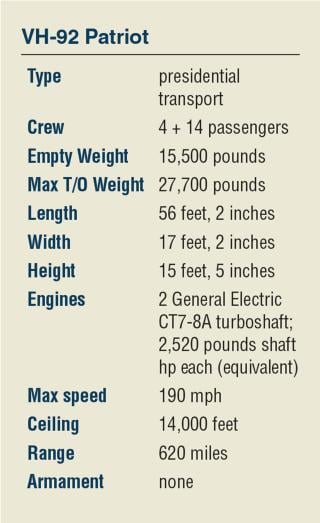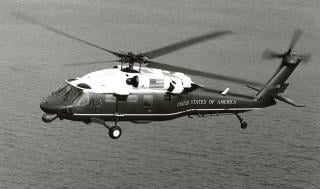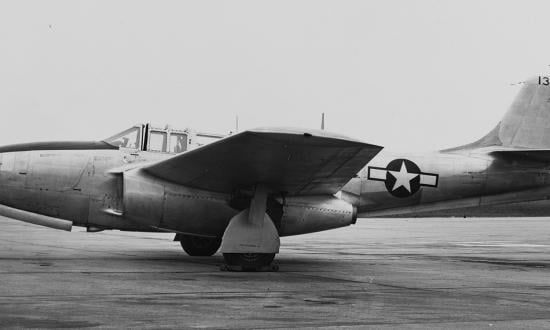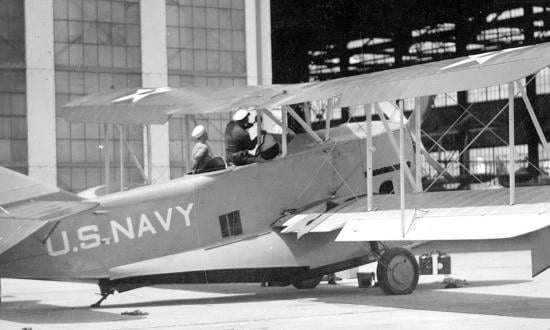U.S. Presidents have used helicopters for official travel since 1957, when President Dwight D. Eisenhower began using a Bell H-13J Sioux to fly between the presidential retreat at Camp David in Maryland and his farm in Gettysburg, Pennsylvania.1
After using the two-passenger H-13J for a brief period, President Eisenhower requested a helicopter with greater capacity. The Sikorsky HUS/H-34 Seahorse became the next presidential helicopter, although it still lacked the “creature comforts” found in later aircraft, such as air conditioning and a toilet.
In 1961, the Sikorsky VH-3A Sea King stepped into the presidential helicopter role; it was upgraded to the specialized VH-3D configuration in 1978. In 1987, that helicopter was supplemented by the VH-60N White Hawk. Both aircraft were called “White Tops” because of their livery.
From the first presidential helicopter until 1976, the Army and Marine Corps shared responsibility for transporting the President, with an Army helicopter carrying the President assigned the call sign “Army One” and a Marine Corps helicopter given the call sign “Marine One.” In similar manner, helicopters carrying the Vice President were given the call sign “Army Two” or “Marine Two.” In 1976 the Marine Corps assumed full responsibility for the presidential helicopters. The Marine-operated aircraft were assigned to Marine Experimental Squadron 1 (HMX-1).
Both the VH-3D and VH-60N underwent periodic improvements in electronics, navigation, communications, and other features. Thus, by 2001, considerable weight had been added to the helicopters. The extra weight, coupled with the desire to provide more protection for passengers following the terrorist attacks of 11 September 2001, led the Department of Defense to accelerate the effort to field replacement helicopters. The new aircraft would have ballistic armor, radar jamming and deception systems to deter antiaircraft missiles, hardened electronics against a nuclear electromagnetic pulse, and encrypted telecommunication and videoconferencing systems.
In April 2002, the Department of Defense began the VXX program, with the Navy as the lead service. Lockheed Martin was awarded a contract in 2005 for 28 VH-71 Kestrels, a variant of the AgustaWestland AW101. However, only nine VH-71s were delivered, and in June 2009, the VH-71 program was canceled because of massive cost overruns and schedule delays. (The nine VH-71 helicopters that were delivered were sold to Canada for parts.)
In May 2014, Sikorsky was awarded a contract for six S-92 helicopters and two training simulators, with an eventual fleet of 21 helicopters planned for presidential use. The aircraft were designed to carry 14 passengers and several thousand pounds of baggage and equipment and had a greater range than the VH-3D and VH-60N. In presidential service they were designated VH-92A Patriot.
The VH-92A first flew on 28 July 2017. The helicopter subsequently failed to meet reliability, availability, and maintenance thresholds, and although it was credited with achieving initial operational capability on 28 December 2021, it was not approved for presidential transport because of problems with the encrypted communication system and other issues.2
To provide security for the President, Marine One always flies in a group of up to five identical helicopters, with one carrying the President and the others serving as decoys. After takeoff the helicopters shift in formation to obscure the location of the President. This has been referred to as the “presidential shell game.”
Marine One is fitted with standard military antimissile countermeasures, such as flares to counter heat-seeking missiles and chaff to counter radar-guided missiles, as well as AN/ALQ-144A infrared countermeasures.
When the President travels away from Washington, D.C., within the United States or overseas, military cargo aircraft transport the helicopters (as well as specialized limousines) to the destination. If the President does not use Marine One when on a foreign trip, at least one U.S. helicopter is on standby at a local airport or air base in the event of an emergency.
Helicopter transport has become a common, almost everyday means of travel for the President.
1. First known as Hi-Catoctin, Camp David was built in the 1930s as a camp for federal government families. President Franklin D. Roosevelt converted it into a presidential retreat in 1942, and it was renamed Shangri-La, the mythical kingdom in the 1933 novel Lost Horizons by author James Hilton. In 1953, President Eisenhower renamed the facility Camp David to honor his father and grandson. It is staffed and guarded by Navy and Marine Corps personnel.
2. Sikorsky Aircraft is now a Lockheed Martin company.











